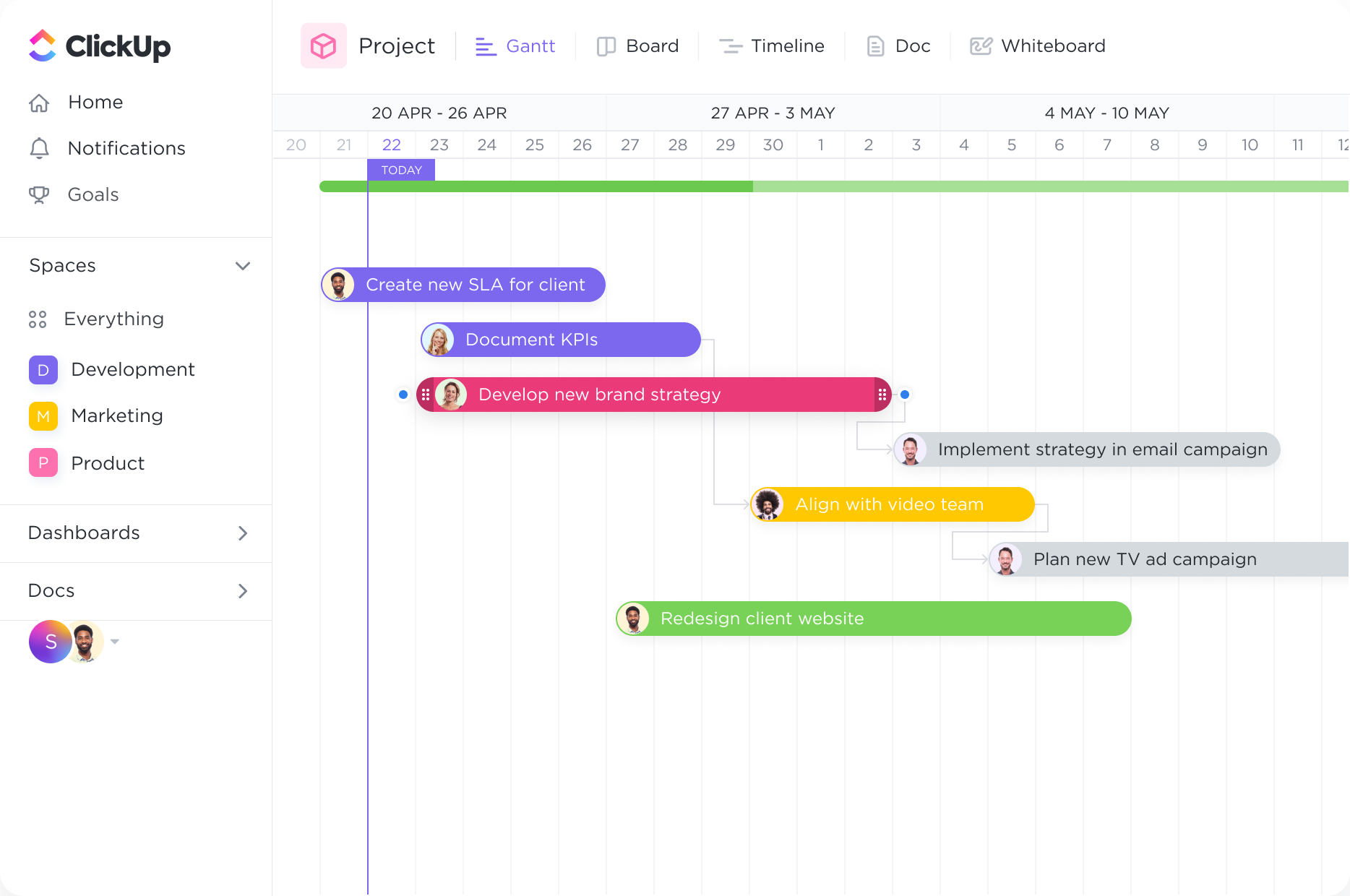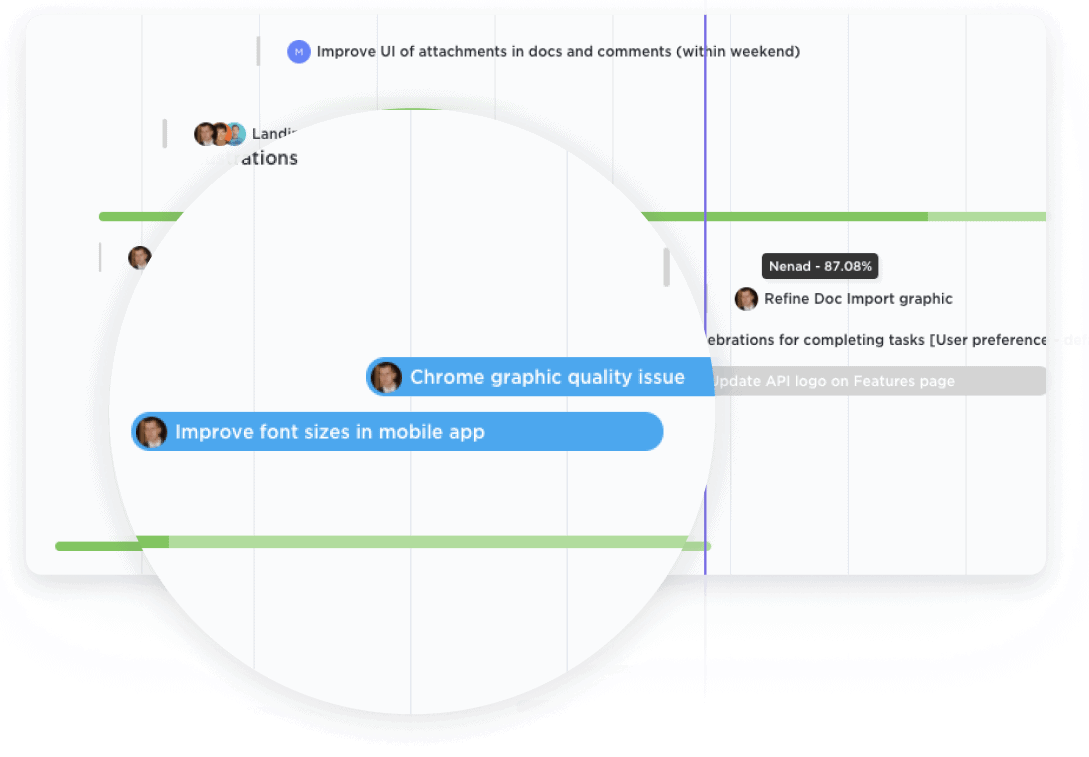Visualize
Organize and set priorities.
Organize how you see your tasks with quick sorting. Create cascading views with a single click to easily see what important tasks are coming next.
Gantt Charts
Streamline your project management process with ClickUp's Gantt Chart software designed specifically for Structural Engineers. Plan, track, and collaborate on projects seamlessly with intuitive features that ensure efficient scheduling and resource allocation. With ClickUp, you can easily visualize project timelines, identify critical paths, and stay on top of deadlines to deliver exceptional results. Take control of your projects and boost productivity with our powerful Gantt Chart software.
Free forever. No credit card.

Visualize
Organize how you see your tasks with quick sorting. Create cascading views with a single click to easily see what important tasks are coming next.
Overview
Get a bird's-eye view of all Spaces, Projects, Lists, and tasks in one Gantt chart. With clear coloring options, you can easily see what work is happening and where.

Structural engineers often work on complex projects with multiple phases and deadlines. Gantt charts provide a visual representation of the project timeline, allowing engineers to easily track and manage tasks, deadlines, and milestones. This helps ensure that projects stay on track and are completed within the specified timeframes.
Structural engineering projects require the allocation and management of various resources, including personnel, equipment, and materials. Gantt charts enable engineers to effectively allocate resources by visually representing their availability and utilization throughout the project. This helps optimize resource allocation, prevent overbooking, and ensure that the necessary resources are available when needed.
Structural engineering projects often involve collaboration among team members, including architects, contractors, and other stakeholders. Gantt charts facilitate effective collaboration by allowing engineers to assign tasks to specific team members, set dependencies, and track progress. This promotes transparency, accountability, and efficient teamwork, leading to smoother project execution.
Gantt charts are particularly useful in planning and managing the phasing and sequencing of construction activities in structural engineering projects. Engineers can break down the project into smaller tasks and visually represent their dependencies and order of execution. This helps ensure that construction activities are carried out in the correct sequence, minimizing errors and delays.
Structural engineering projects often involve inherent risks and uncertainties. Gantt charts can be used to identify potential risks, plan for contingencies, and mitigate the impact of unforeseen events. By visualizing the critical path and dependencies, engineers can proactively address risks, adjust timelines, and allocate resources to minimize disruptions and maintain project progress.
Structural engineering projects require thorough documentation and reporting to ensure compliance, quality control, and project transparency. Gantt charts provide a comprehensive overview of project progress, allowing engineers to track and document completed tasks, milestones, and deliverables. This simplifies the reporting process and provides stakeholders with a clear and concise visual representation of the project's status.
A Gantt chart can help structural engineers keep track of different projects and visually display their timelines, allowing for better management and coordination.
With a Gantt chart, structural engineers can clearly see the tasks and their dependencies, enabling them to allocate resources efficiently and avoid overloading team members.
By analyzing the Gantt chart, structural engineers can identify the critical path of a project, which is the sequence of tasks that must be completed for the project to finish on time. This helps them identify potential delays and take corrective actions to mitigate them.
A Gantt chart can serve as a communication tool to share project progress and timelines with clients, contractors, and other stakeholders. It provides a clear visual representation of the project's status and helps in effective collaboration and decision-making.
Structural engineering projects often have tasks that depend on each other or are interdependent. A Gantt chart can help identify these dependencies and ensure that tasks are scheduled and executed in the correct order.
Structural engineering projects often have important milestones that need to be met. A Gantt chart can track these milestones and provide a visual representation of their progress, allowing for better control and management of the project.
Gantt chart software can help structural engineers in planning and managing projects more effectively. It provides a visual representation of project timelines, tasks, and dependencies, allowing engineers to easily track progress and identify potential bottlenecks. It also enables resource allocation and helps in coordinating tasks among team members. Additionally, Gantt charts facilitate communication and collaboration, ensuring that all stakeholders are aware of project status and deadlines. Overall, using Gantt chart software enhances project efficiency and helps structural engineers deliver projects on time and within budget.
Yes, Gantt chart software can help in managing complex construction projects with multiple dependencies and stakeholders by providing a visual representation of project timelines and dependencies. It allows for the identification of critical paths, resource allocation, and the tracking of project progress. This enables effective coordination among stakeholders, improves communication, and ensures timely completion of tasks and milestones.
Yes, it is possible to integrate Gantt chart software with other project management tools commonly used by structural engineers. This integration allows for seamless data transfer, real-time updates, and improved collaboration between different tools, streamlining project planning and resource allocation processes.